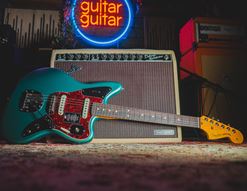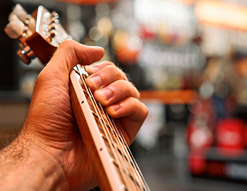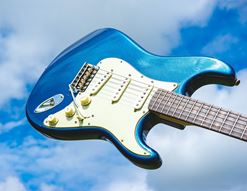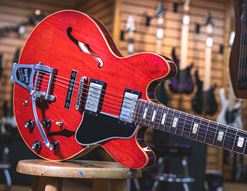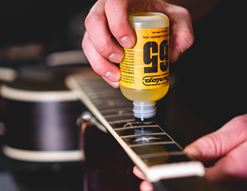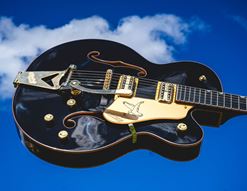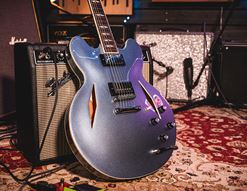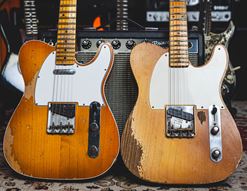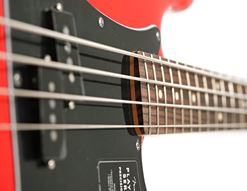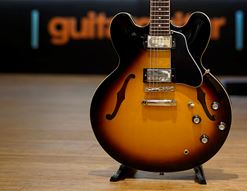Whammy bars. Tremolos. Vibrato bars. Wang bars. Wiggle sticks.
These are all names for the same thing. Some guitars have them, and today’s blog is all about them.
What is a whammy bar? What does it do? Do you even need one? If you’re feeling like you need answers to these burning questions, then drop whatever you are doing and read this blog!
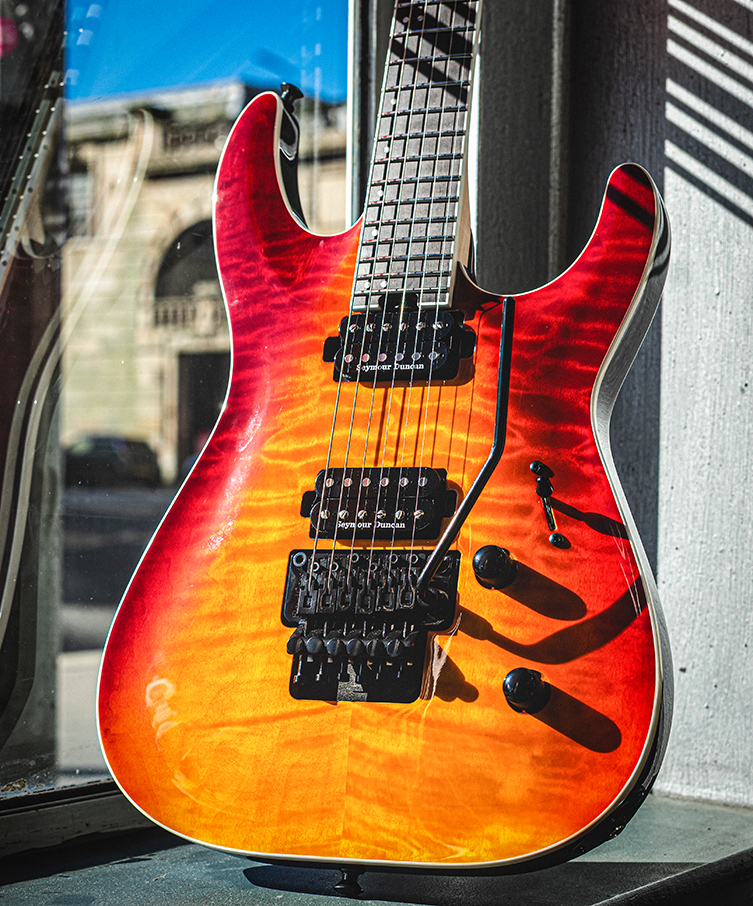
Contents
What are the Parts of a Whammy Bar?
The Greatest Practitioners of the Whammy Bar
What is a Whammy Bar?
- Whammy bars let you change the pitch of notes by physically moving the bar.
- You push the whammy bar towards the guitar’s body and it drops the pitch of the strings.
Let me deal with the big one first: just what is a ‘whammy bar’? Well, for one thing, the term ‘whammy bar’ itself is a bit of a nickname. I’ll continue using it throughout this blog though, because as you’ll soon find out, the other terms can get pretty confusing…
A whammy bar is a mechanical device that manipulates the pitch of guitar strings by temporarily easing the tension of the strings. The ‘bar’ is usually attached to the guitar’s bridge, and the player depresses the bar, which moves the bridge saddles forward, releasing string tension and dropping the pitch of a note. You push the whammy bar towards the guitar’s body and it drops the pitch of the strings, basically.
In other words, you are willfully putting the guitar out of tune a bit, and then releasing the bar and returning the string to its original pitch. The result can be a subtle wobble, a mean growl, or the sound of a motorbike engine, depending on how much you press down.
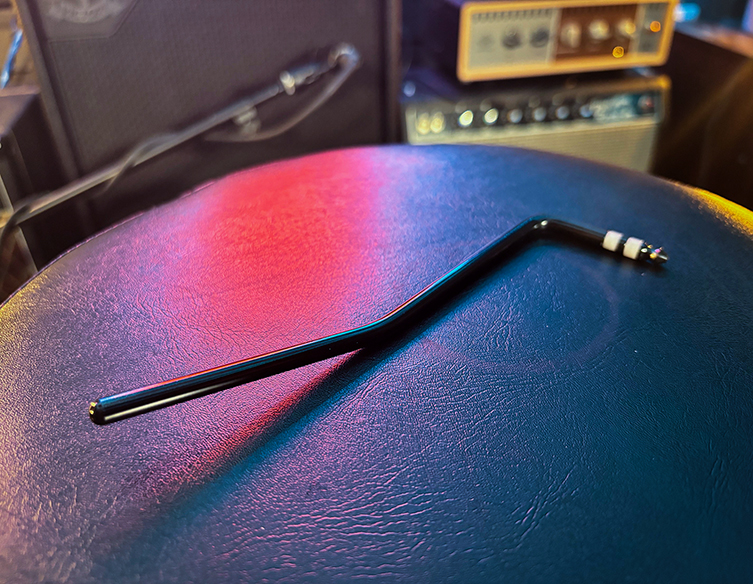
What are the Parts of a Whammy Bar?
- Bridge: the moving part that strings are fed through
- Springs: they allow the bridge to move
- Bar/arm: the whammy bar itself, the metal stick you move with your hand
There are a few different types of whammy bar design out there, and I’ll look at each of them in turn soon. First, let’s understand the device a little bit better by checking out its parts, which are: bridge, bar (or arm) and springs.
- Bridge: all guitars have bridges of course, but those with whammy bars need to be able to move. Typically, there will be saddles for each string, a large metal block at the bottom of the bridge for stability (you normally can’t see it) and a hole to attach the tremolo arm.
- Bar: This is sometimes called ‘the arm’, and is the part you as the guitarist use to manipulate the unit and change pitch. The bar can be fixed to the bridge, or it can be screwed or pushed in.
- Springs: the springs provide the point of movement and the method of returning to pitch. Without springs in the equation, whammy bars cannot work. Mostly, you’ll find the springs located in the back of the guitar’s body, though certain models (the Bigsby for example) features the spring directly under the whammy bar itself.
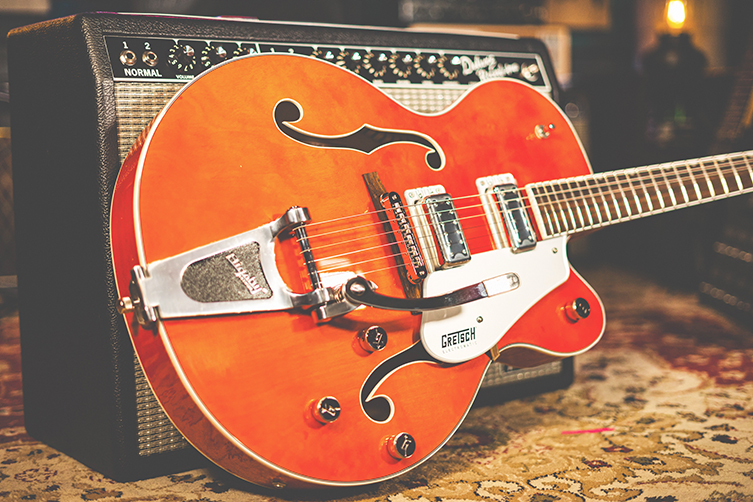
How Does a Whammy Bar Work?
- Pushing or pulling the bar changes string tension
- Tension changes alters the pitch of any notes being played
- Different whammy bars offer differ degrees of 'give' on the notes
A whammy bar uses a spring or a set of springs (depending on the style of whammy bar) to let the player push down and drop the pitch of notes. The springs get taut and then push back on the bridge to return the notes to their original tension when you let up on pushing the bar down.
Some whammy bars are set so that they can push down only (a drop in pitch) and others are set to ‘float’, meaning that you can also pull up on the guitar - away from the body as opposed to ‘down’ towards it - to raise the pitch, too.
Pushing gently allows a slight variation in pitch that is similar to the type of vibrato that you can produce with your hands. In fact, floating tremolos are able to produce ‘true vibrato’ by lowering and raising the pitch a fraction either way.
Pushing the bar further towards the body will drop the pitch more dramatically. Different whammy bars will be able to go further than some others, and I’ll go into this in a second.
Tuning Stability
- Any part of the guitar that meets the string can alter tuning stability
- Locking tremolos are best for staying in tune
Tuning stability is something to consider with any whammy bar. Since the whole operation of a whammy bar is to temporarily detune the string(s), it stands to reason that tuning issues may develop. This is true to a degree.
Any element of the guitar that comes into contact with the string can affect tuning stability, so the bridge saddles, nut and other factors play a part. When using a whammy bar, the strings slacken and come sometimes get caught in the nut, for example. A good set up and regular maintenance (see below) can help mediate these issues, though.
Some types of whammy bar use locking mechanisms to securely hold strings in place. Though not 100% perfect, they are generally very effective at keeping strings in tune.
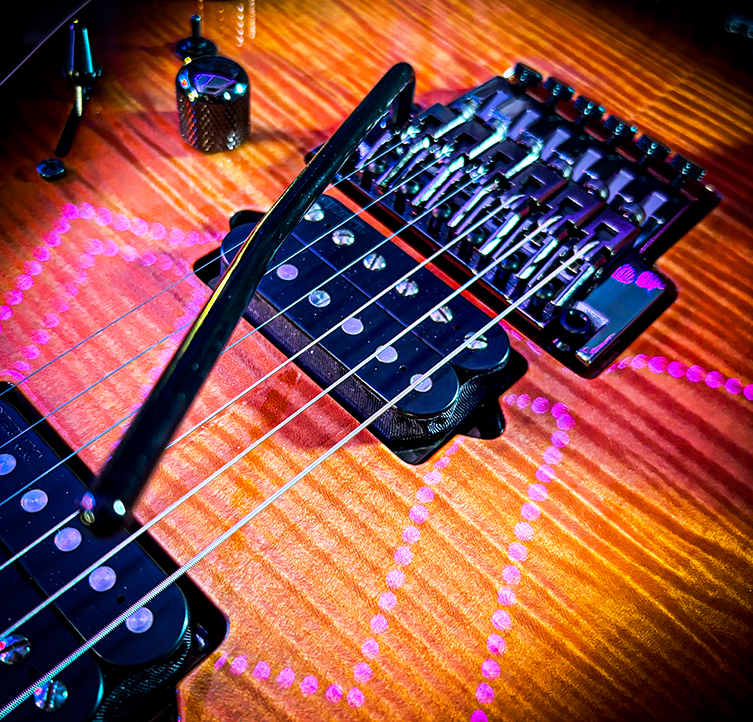
Two more factors worth bearing in mind:
If you break a string, your entire guitar will be wildly out of tune
You can’t retune a single string on its own without it making all of the other strings go out, too. Even for Drop D tuning, you’ll have to retune every single string. Guitars with hard tail bridges are far less susceptible to this tuning slippage.
Tremolo or Vibrato?
- Tremolo = volume
- Vibrato = pitch
- Blame Fender
Tremolo is a term for rapid volume changes like you’d get with a tremolo pedal.
Vibrato is a term for pitch fluctuation.
Therefore, whammy bars perform vibrato, not tremolo! You can blame Fender for this mixup, since they named their Stratocaster whammy bar the ‘Synchronised Tremolo’ back in 1954.
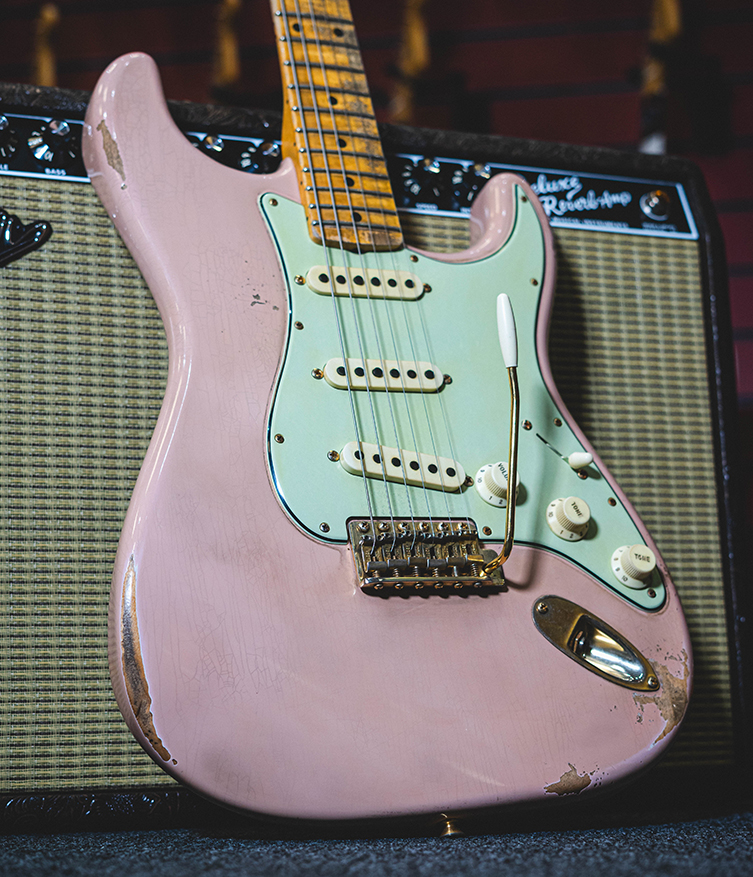
Types of Whammy Bar
Here are the main types of whammy bar that you’ll find on guitars today. I’ll go more or less chronologically, though this is less about history and more about understanding the differences in type.
Bigsby
This design actually sits on top of the guitar instead of inside it, so there is no need for big holes to be routed into the guitar body. This is why you’ll see lots of semi hollow guitars featuring Bigsby tremolos: it’s the only type that will fit!
The Bigsby tremolo is very distinctive to look at, and is liked as much for its aesthetic contributions as its sonic ones! In fact, the Bigsby only offers a shallow amount of pitch bending. You can raise and lower the pitch, but more subtle shifts are what you get.
Unlike most whammy bars, the Bigsby sits separately behind the guitar’s bridge, and operates somewhat independently of it.
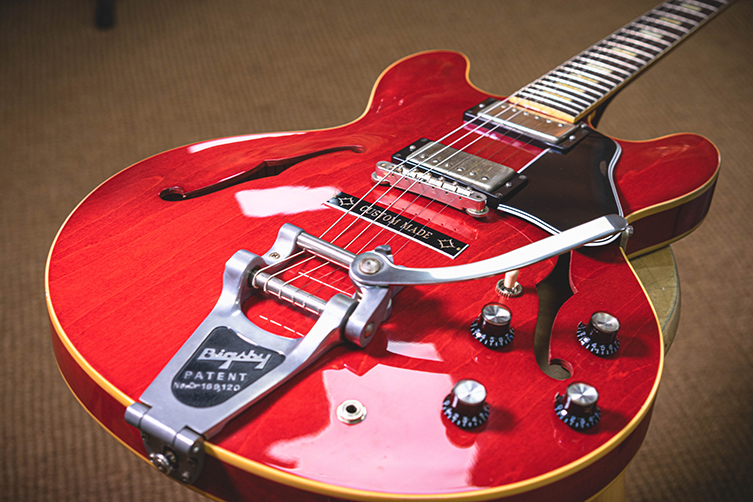
Maestro
Maestro is another surface-mounted tremolo which operates in a more-or-less similar way to the Bigsby, though superficially it looks pretty different. You’ll see the Maestro ‘Vibrola’ (it’s just a trademark term) on old 60s (and indeed reissue model) Gibson SGs & Firebirds, and you can recognise them by their distinctive metal plates that cover up the device’s mechanism.
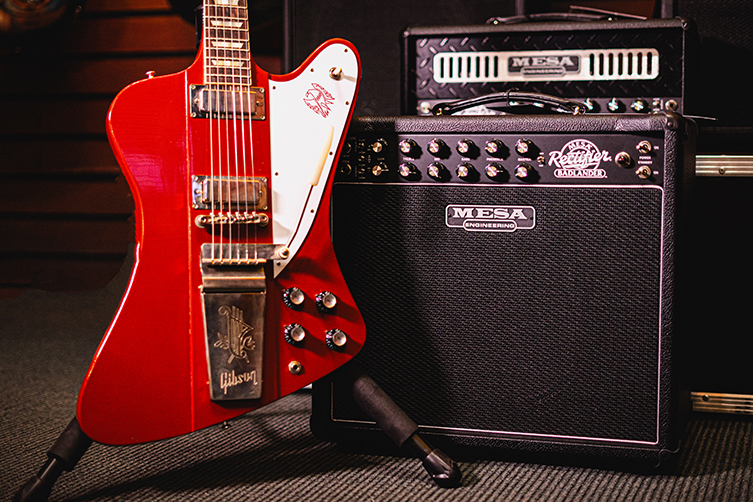
Synchronized Tremolo
This is far and away the most popular type of whammy bar. It was developed by Leo Fender for his Stratocaster guitar, and it’s the main reason why most of us talk about ‘tremoloes’ when the effect in question is actually vibrato.
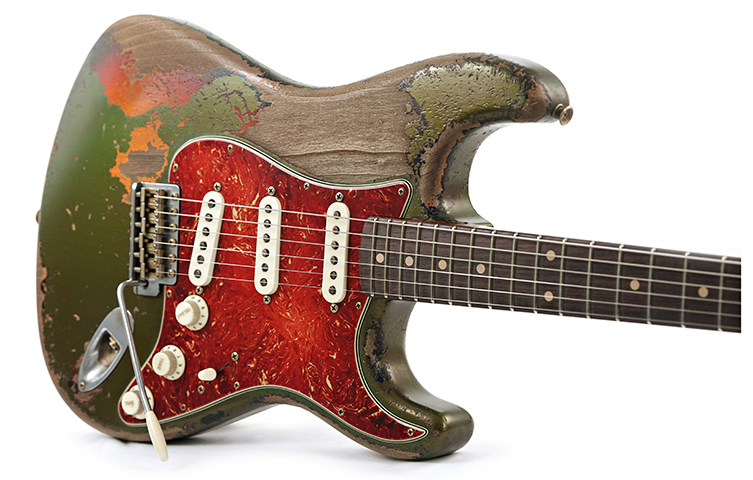
The ‘Strat whammy bar’ is the blueprint for most of the styles that came after it. It’s the first type to use springs embedded in the guitar body. You can drop the pitch a fair amount more with this style over the Bigsby - including some divebomb-style noises in addition to more subtle use - and for that reason it is maybe the best starting point for most people.
Lots of other guitar companies use this style, and it is often referred to as a ‘vintage tremolo’. Variations in design from brands like Gotoh, PRS, Suhr and Wilkinson exist too, all refinements on the theme.
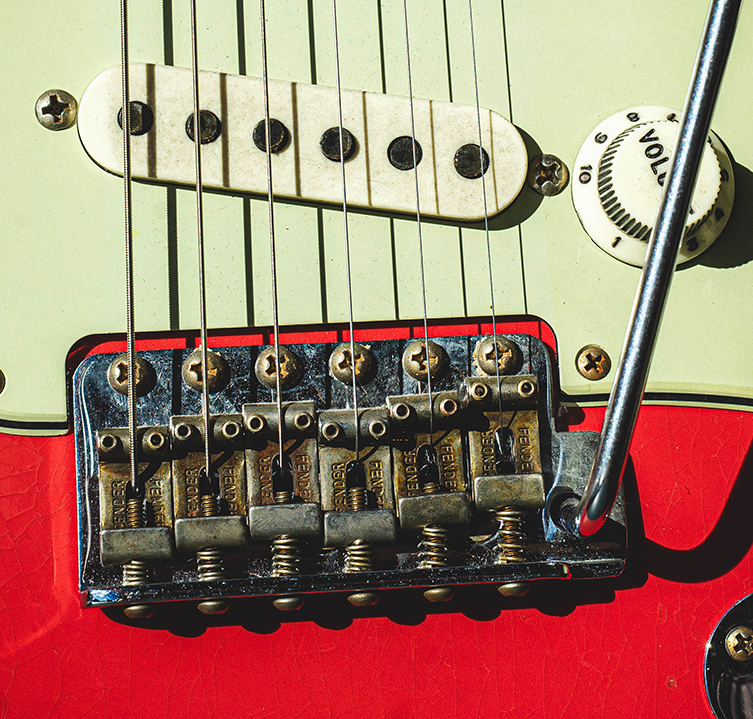
Fender Offset Tremolo
The type of whammy bar you find on Jazzmasters, Jaguars and their offset kin are pretty unique. They have a similar range to a Bigsby, but don’t feel like those at all, nor do they operate or look like them.
Positioned quite far from the guitar’s bridge, the offset whammy bar has a metal plate underneath a metal plate, which provides the ‘travel’ of the notes.
The extra-long arm is very cool or hideous, depending on your sensibilities, but it definitely allows for certain ‘glide guitar’ techniques that other whammy bars are less good at facilitating.
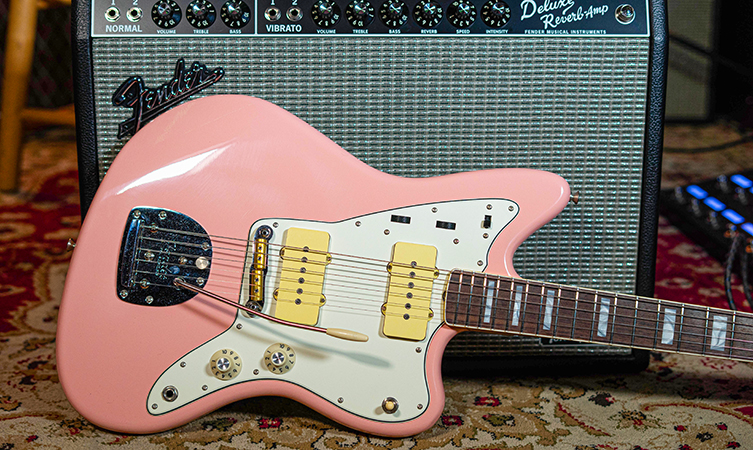
Floyd Rose Tremolo
The Floyd Rose tremolo was the first ever locking tremolo system, and remains the most popular. In simple terms, the Floyd Rose locks the string in place at the bridge (you snip off the ball end of the string first) and also at the nut through a special locking nut device. After that, the strings are fully locked in and don’t budge, no matter how hard you use the whammy bar.
Aside from tuning stability, the best thing about ‘the Floyd’ is that it can reduce string tension much, much lower than other whammy bars, to the point of the strings going slack like spaghetti! A whole vocabulary of unorthodox sounds are made possible via manipulation of the Floyd Rose tremolo, and many expressive lead guitarists have fully incorporated it into their style.
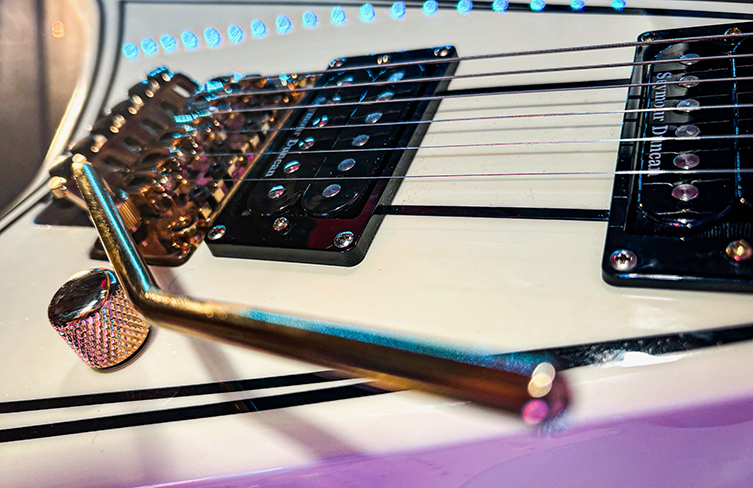
The obvious downside is that you cannot realistically retune your guitar after everything is locked in place, meaning that you may need to bring more than one guitar to a gig, if you need multiple tunings.
Another issue is that broken strings will still affect the tuning of other strings, unless the bridge is ‘flush-mounted’, which stops it from moving back and raising the pitch of notes. When set up like this, the whammy bar will operate ‘downwards’ only, though tuning stability improves with broken strings.
Kahler Tremolo
You don’t often see Kahlers these days, mainly due to them losing the battle for supremacy in the marketplace to Floyd Rose. The Kahler is somewhat different in design to the Floyd, with all of the strings sitting on top of the guitar on unique roller saddles.
The Kahler allowed similar levels of pitch manipulation to the Floyd Rose but had a different playing feel. Ultimately, players seem to prefer the Floyd, though Kahlers are still out there, so who knows what the future might bring?
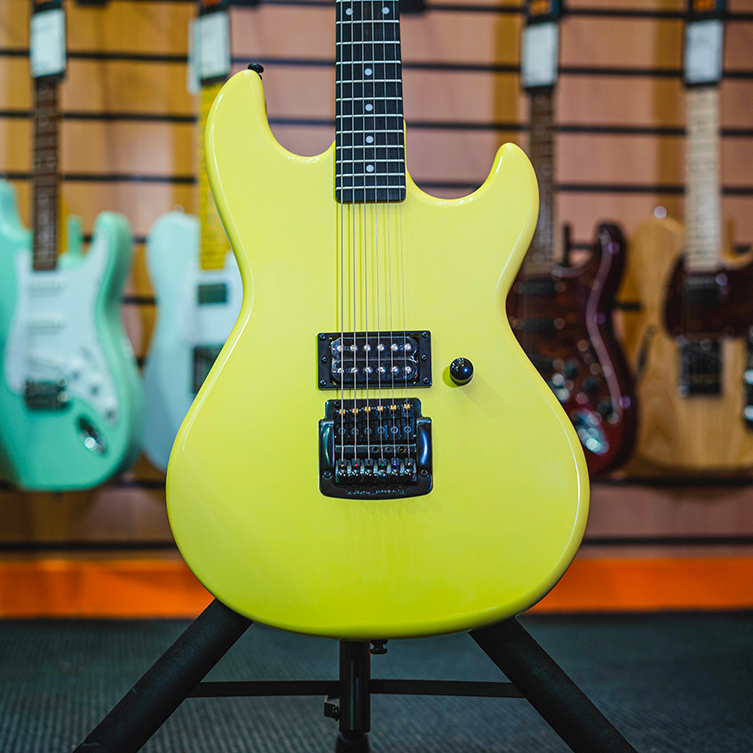
Whammy Bar Maintenance
Looking after a whammy bar isn’t particularly complex or difficult: it’s just a matter of keeping in mind what it is and how it functions.
Here are some easy tips to make sure your whammy bar sounds wild in a good way, not in a pathetic/amateur/loser way.
- Graphite in the nut slot: you already do this with all of your guitars anyway, don’t you? The nut needs to be lubricated with either the graphite from a pencil (yes, literally ‘draw’ in the nut slots) or from a proper nut lubricant product. Do this maybe twice a year. I’m hoping you change your strings more often than that though…right? Some players lubricate the saddles too (makes sense, it's another area of contact with the strings) but I haven’t personally done that.
- Stretch those strings: again, you should be doing this anyway, but proper stretching of new strings will stop the whammy bar from doing it for you.
- Check the springs: have a look at them maybe once a year. They might eventually stretch out and be less useful, but I’ve actually never encountered this myself. Still, it takes seconds to look!
- Inspect the saddles: Not all whammy bar bridges are made equal. Cheaper metals, moulded pieces rather than machined parts and other factors can add up to a less than amazing whammy bar. The saddles are worth looking at, and if the guitar was a particularly affordable one, I’d maybe even consider upgrading the saddles if I were you. It’s an effective way to have an instantly better guitar, particularly if the saddles are looking a little worn.
The Greatest Practitioners of the Whammy Bar
For a final bit of fun, I thought I would collect some examples of superlative whammy bar histrionics, just to give you the full picture of what can be done with a whammy bar. I won’t say too much unless it’s appropriate, because this final part of the blog is just supposed to be a wham-bam gallery of inspiration. Enjoy it, and have fun with your whammy bar!
Jimi Hendrix - Star Spangled Banner
Check out the wild expression Jimi gives to this famous rendition/protest, with his whammy bar approximating the bombs exploding over in Vietnam. It still gives shivers, all these years later.
Van Halen - Judgement Day
It would be a little big glib to write ‘any Van Halen song’ here, given how influential Ed was on whammy maniacs. Most players would point towards his signature Eruption showpiece, so let me bring up a whole different era, and an example where the whammy bar is integral to the song’s main riff.
Jon Bon Jovi - Blaze of Glory
'Jon Bon' is not an expert on the whammy bar as far as I know, but his late pal Jeff Back certainly was. Check out this ‘slide’ solo, and marvel that it was done entirely with the whammy bar, with nary a slide in sight.
Joe Satriani - Ice 9
Satch is obviously quite into his whammy moments, but Ice 9 from Surfing with the Alien really takes the biscuit. There are three absolute rippers of solos on this tune - one after the other, with different tones - but it’s the third one that always drops my jaw. Give it a listen and realise that every single otherworldly shriek and alien scream is just Joe with his whammy bar and stupendously exacting technique.
Pantera - Cemetery Gates
Dimebag did so many cool things with the whammy bar. Cemetery Gates is far from my favourite Pantera tune, but just dig how he copies Anselmo’s vocals with his whammy bar! Man, we really miss this guy.
Steve Vai - Bad Horsie
This tune is almost a catalogue of awesome things to do with a whammy bar, alongside some raunchy slide action. At the same time.
Polyphia - Aviator
Part of the new generation of shred maniacs, practically every note of this tune uses a whammy bar. From dips to warbles, there’s definitely no attitude of ‘less is more’ with this lot.
My Bloody Valentine - To Here Knows When
It’s not all shred techniques with whammy bars! Kevin Shields makes us seasick with his ‘glide guitar’ sound, but in the most delirious way possible.
Limp Bizkit - Chocolate Starfish
Is Wes Borland THE riff writer of the late 90s and early 00s? This riff is pretty conclusive evidence, and makes the most of his Floyd Rose tremolo. For more like this, check out the similarly mature song Douchebag.
Go and Make a Silly Noise
Whammy bars are all about expression. They can be infuriating, sure, but they also open up your sound and your playing in ways that nothing else can. From sad 1950s twangy romance, to a Kerry King ‘whammy bar solo’ (as opposed to simply a ‘guitar solo’), the whammy bar/ tremolo/vibrato/wang bar/wiggle stick/wommolo bar is there to help you make sounds that cannot otherwise exist.
Have fun wiggling your whammy!

